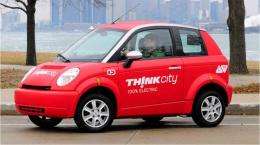More myths busted about electric cars

I recently went to Finland to drive the all-electric Think City plug-in car (thinkev.com), which is already on European roads and coming to the U.S. later this year. To help it have a soft landing, Think CEO Richard Canny (who spent 25 years at Ford) put together these nine myths about electric vehicles (EV). I've had my own version, but Richard's list is quite different and well worth sharing. He's not an objective party, of course, but he has hands-on experience.
Here are Canny's nine electric vehicle myths:
1. You are just moving the pollution out of the cities to the countryside.
Busted: Electric vehicle motors are three-to-five times more efficient than gasoline-powered vehicles. While it's best to power EVs from renewable energy sources (which are growing quickly), the efficiency of EVs makes them cleaner, producing less carbon, under any situation -- even when they are charged using coal-fired electricity.
2. Customers will never buy a car with less than a 200-mile range.
Busted: So-called "range anxiety" diminishes when people get used to driving EVs on a daily basis. It's just like charging a cell phone overnight. You plug it in, and in the morning it's ready to go, fully charged. As more EVs hit the road, businesses and cities will add charging points to encourage EV use. EVs can also be fast-charged (our system goes from zero to 80 percent charged in just 15 minutes) to help cover those rare situations when an EV will be needed to cover more than 100 miles in a single day.
3. The battery won't last.
Busted: EV batteries are designed to last at least 10 years and more than 100,000 miles. There are cars on the road in Europe with batteries approaching the 10-year mark. Some EVs have been on the road in Europe with packs approaching the 10-year-old mark, and modern lithium-ion batteries will definitely meet or exceed that target.
4. You'll need to build a lot more power plants.
Busted: Actually, there's enough off-peak electricity in the U.S. to power 79 percent of U.S. driving demand. As more EVs are deployed, it's important to ensure that the smart-charging (time-based charging management) and vehicle-to-grid connectivity progresses as well. A connected network of millions of micro-energy storage devices (which is what EVs will become) provides significant opportunities to improve the stability and performance of electric grids and better balance peak demand.
5. We're going to run out of lithium - and isn't it poisonous?
Busted: Lithium carbonate today comes from dried salt lakes in South America (Chile, Argentina and Bolivia) and China. There are also other huge sources for lithium, although these are more expensive to develop. Lithium can even be extracted from salt water and projects are under way to do this. The industry will not have a shortage of lithium for the next decade. It is also possible that new battery technologies will be based on other light metals like zinc or nickel. Lithium from used batteries will be recycled in dedicated recycling plants. Lithium batteries contain no poisonous heavy metals like lead in lead-acid batteries or cadmium in NiCd batteries.
6. The infrastructure has to come first.
Busted: The best way to deploy EVs is to get cars on the road first, then add infrastructure. If there are no EVs to use those plugs and parking spots, people see it as wasteful. We think infrastructure is a small part of good policy at a federal, regional and local level to support EV early adopters.
7. They're not safe.
Busted: Highway-certified EVs meet all the same safety and crash test requirements as regular production cars with some important extras.
8. The technology is too complicated.
Busted: A modern electric car has only about five main moving parts compared with hundreds in an internal-combustion engine. There are no regular visits to the dealership for an EV. No oil changes, no filters -- even brake pads last two-to-three times longer than in conventional cars, because EVs use regenerative braking to recapture the energy that would otherwise be lost while braking. Your first trip to the dealership with an EV for scheduled maintenance is at 40,000 miles to check the brake pads. Eventually, you'll need new wiper blades and tires. But that's about it!
9. Fast charging EV batteries in 15 minutes will wear them out quickly.
Busted: Modern prismatic lithium batteries can be developed with fast-charging in mind. The critical technology is in the cell design to manage battery temperature during charging. Limiting fast charging to the zero to 80 percent range also protects battery life. We think that 95 percent or more of all EV miles will be driven on cars charged during overnight off-peak periods when electricity is cheaper and readily available. Fast charging locations provide reassurance and peace of mind for those occasional days where more than 100 miles are required.
More information: Earlier story: Five myths about electric cars - www.physorg.com/news188543729.html
(c) 2010, Mother Nature Network.
Distributed by McClatchy-Tribune Information Services.





















